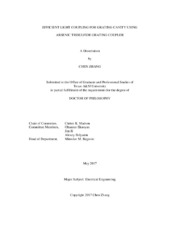| dc.description.abstract | In this dissertation, design, fabrication and measurement of arsenic trisulfide (As2S3) grating couplers have been demonstrated on both bulk lithium niobate (LiNbO3) substrate and thin film LiNbO3. Photonic design tools, including Fimmwave and Fimmprop, are used for optical modelling. Python scripts are used to optimize the results. Standard semiconductor processing techniques are employed to fabricate the proposed grating couplers. In particular, electron beam lithography (EBL) is used to pattern sub-micron fine features in these grating couplers. The grating couplers are measured using an optical vector analyzer.
As2S3 grating coupler on bulk LiNbO3 substrate has a theoretical coupling loss of 2.55 dB, while the measured coupling loss is 3.75 dB. The bandwidth of this coupler is 80 nm. The reason for the measured loss being higher than the theoretical value is fabrication imperfection. As2S3 grating coupler on thin film LiNbO3 has a theoretical coupling efficiency as high as 78.8% after optimization. A simplified grating coupler structure on thin film LiNbO3 is fabricated and measured, with 6.3 dB coupling loss. Reflection response of a grating cavity is measured by this coupler. The fitted result shows 2.0 dB/cm propagation loss of the As2S3 cavity waveguide. If the cavity waveguide width is tapered to 0.4 μm, 82.3% of light can be confined in the LiNbO3 layer. This high optical mode confinement factor in LiNbO3, together with the excellent electro-optic (EO) property of LiNbO3 crystal, makes such a grating cavity a promising high-speed, low-loss tunable filter.
An optical low-coherence interferometer (OLCI) setup is designed and built. The low-coherence source is generated by a supercontinuum source with a bandpass filter. Interference fringes occur when one of the arms includes a variable delay line. By Fourier transform of the fringes, the spectral density of the source is obtained and analyzed. The setup has been tested in the near-infrared wavelength range, and it can also be used to characterize mid-infrared optical passive devices. | en |


